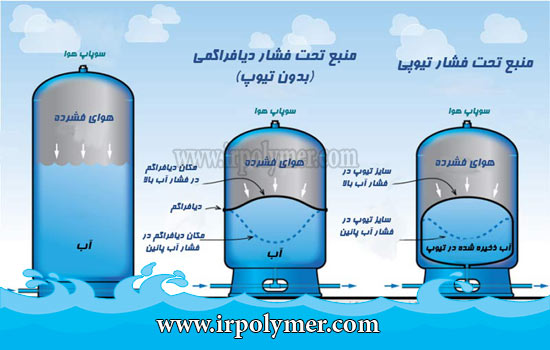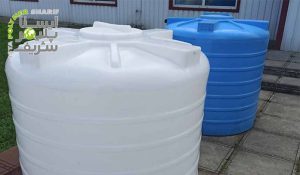Pressure tanks, used for storing water and reducing the need for frequent use of a water pump, can maintain pressure in two ways: with a diaphragm or a bladder. In this article from ABtank, we will explore how diaphragm pressure tanks work and their applications.
How Diaphragm Pressure Tanks Work
A diaphragm tank is typically installed next to a water pump motor or, if it’s not too large, directly on the pump. This tank stores water in a way that eliminates the need for the pump to turn on and off frequently, thereby reducing noise and electricity consumption. Additionally, it decreases pump wear and tear, extending its lifespan. The question is, how does a diaphragm pressure tank work? Inside the diaphragm tank, there is a plastic membrane that separates the air (the dry section) from the water. A valve in the dry section allows air to enter the tank under pressure. In the water section, there is an outlet valve connected directly to the pump. When the pump operates, water enters the dry section of the tank, reducing the pressure of the stored air. The pump then shuts off. When water is used by the building’s residents, the diaphragm returns to its original state, pushing the stored air into the pipes to maintain water flow. Diaphragm pressure tanks are generally more durable than bladder-type tanks and can be made from materials such as fiberglass or steel.
Operation of Diaphragm Pressure Tanks
The operation of a diaphragm pressure tank can be summarized as follows:
- The pump starts working, and when the pressure inside the tank reaches an ideal level, the pump turns off.
- At this stage, water is ready for use with sufficient pressure, and when a faucet is opened, the pressure inside the water tank directs the water into the pipes instead of the pump.
- This process continues until the pressure inside the tank drops to zero (its initial state).
- When the pressure reaches zero, the pump starts again and begins to operate.
- Water is collected in the tank (up to its maximum capacity), and when the tank pressure reaches the ideal level, the pump turns off.
Notes on Diaphragm Pressure Tanks
- The air pressure in a diaphragm pressure tank depends on the number of floors in the building and the household’s water consumption.
- The most common and widely used size for residential purposes is 24 liters, suitable for buildings with 1 to 3 floors.
- The power of the connected water pump will also affect the choice of the pressure tank and its size.
- A larger tank does not necessarily mean higher water pressure! The pump is what influences the water pressure.






